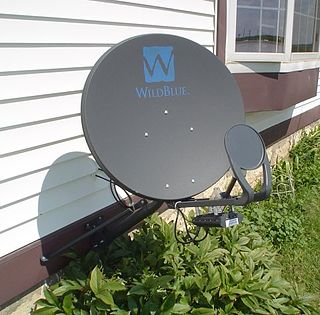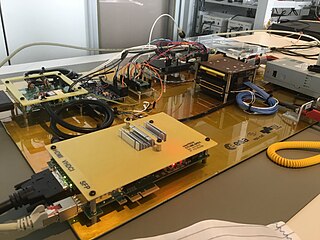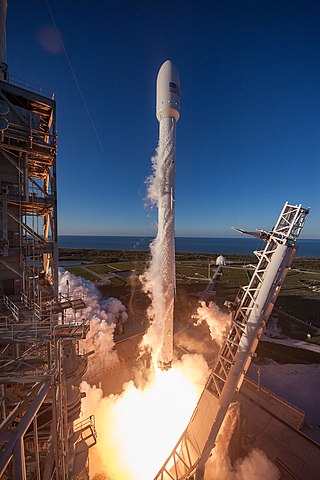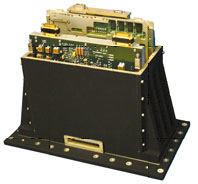Latency, from a general point of view, is a time delay between the cause and the effect of some physical change in the system being observed. Lag, as it is known in gaming circles, refers to the latency between the input to a simulation and the visual or auditory response, often occurring because of network delay in online games.

STS-41 was the 36th Space Shuttle mission and the eleventh mission of the Space Shuttle Discovery. The four-day mission had a primary objective of launching the Ulysses probe as part of the "International Solar Polar Mission" (ISPM).

Satellite Internet access is Internet access provided through communication satellites; if it can sustain high speeds, it is termed satellite broadband. Modern consumer grade satellite Internet service is typically provided to individual users through geostationary satellites that can offer relatively high data speeds, with newer satellites using the Ku band to achieve downstream data speeds up to 506 Mbit/s. In addition, new satellite internet constellations are being developed in low-earth orbit to enable low-latency internet access from space.
Surrey Satellite Technology Ltd, or SSTL, is a company involved in the manufacture and operation of small satellites. A spin-off company of the University of Surrey, it is presently wholly owned by Airbus Defence and Space.

SES S.A., trading as SES is a Luxembourgish satellite telecommunications network provider supplying video and data connectivity worldwide to broadcasters, content and internet service providers, mobile and fixed network operators, governments and institutions.
CLEO - Cisco router in Low Earth Orbit, is an Internet router from Cisco Systems that was integrated into the UK-DMC Disaster Monitoring Constellation satellite built by Surrey Satellite Technology Ltd (SSTL) as a secondary experimental hosted payload, and launched into space with the satellite from Plesetsk on 27 September 2003.
The Disaster Monitoring Constellation for International Imaging (DMCii) or just Disaster Monitoring Constellation (DMC) consists of a number of remote sensing satellites constructed by Surrey Satellite Technology Ltd (SSTL) and operated for the Algerian, Nigerian, Turkish, British and Chinese governments by DMC International Imaging. The DMC provides emergency Earth imaging for disaster relief under the International Charter for Space and Major Disasters, which the DMC formally joined in November 2005. Other DMC Earth imagery is used for a variety of civil applications by a variety of governments. Spare available imaging capacity is sold under contract.
Intelsat 14 is a communications satellite owned by Intelsat located at 45° West longitude, serving the Americas, Europe, and African markets. Intelsat 14 replaced Intelsat 1R which was at the end of its design life. It was built by Space Systems Loral, as part of its LS-1300 line.

O3b is a satellite constellation in Medium Earth orbit (MEO) owned and operated by SES, and designed to provide lower-latency broadband connectivity to remote locations for mobile network operators and internet service providers, maritime, aviation, and government and defence. It is often referred to as O3b MEO to distinguish these satellites from SES's O3b mPOWER constellation.
Intelsat 19 is a geostationary communications satellite operated by Intelsat. It was constructed by Space Systems/Loral, based on the LS-1300 satellite bus. It was successfully launched by Sea Launch using a Zenit-3SL launch vehicle on 1 June 2012 at 05:22:59 UTC. Upon entering service it replaced Intelsat 8 at 166° East Longitude.
Orion 3 was an American spacecraft which was intended for use by Orion Network Systems, as a geostationary communications satellite. It was to have been positioned in geostationary orbit at a longitude of 139° East, from where it was to have provided communications services to Asia and Oceania. Due to a malfunction during launch, it was instead delivered to a useless low Earth orbit.
The SSL 1300, previously the LS-1300 and the FS-1300, is a satellite bus produced by Maxar Technologies. Total broadcast power ranges from 5 to 25 kW, and the platform can accommodate from 12 to 150 transponders. The SSL 1300 is a modular platform and Maxar Technologies no longer reports designators for sub-versions, such as: 1300E, 1300HL, 1300S, 1300X.
A hosted payload is a module attached to a commercial satellite with communications circuitry that operates independently of the main spacecraft but which shares the satellite's power supply and transponders. The concept has been also been referred to as "piggybacking" or "hitchhiking."

OPS-SAT was a CubeSat by the European Space Agency (ESA), intended to demonstrate the improvements in mission control capabilities that will arise when satellites can fly more powerful on-board computers. The mission had the objective to break the cycle of "has never flown, will never fly" in the area of satellite control. It was the first CubeSat operated directly by ESA.
Intelsat 33e, also known as IS-33e, was a high throughput (HTS) geostationary communications satellite operated by Intelsat and designed and manufactured by Boeing Space Systems on the BSS 702MP satellite bus. It was the second satellite of the EpicNG service, and covered Europe, Africa and most of Asia from the 60° East longitude, where it replaced Intelsat 904. It had a mixed C-band, Ku-band and Ka-band payload with all bands featuring wide and C- and Ku- also featured spot beams.
Intelsat 29e, also known as IS-29e was a high throughput (HTS) geostationary communications satellite designed and manufactured by Boeing Satellite Development Center on the BSS 702MP satellite bus. It is the first satellite of the EpicNG service, and covers North America and Latin America from the 50° West longitude, where it replaced Intelsat 1R. It also replaced Intelsat 805 which was moved from 56.5° West to 169° East. It has a mixed C-band, Ku-band and Ka-band payload with all bands featuring wide and the Ku- also featuring spot beams.

Intelsat 35e, also known as IS-35e is an Intelsat high-throughput (HTS) geostationary communications satellite designed and manufactured by Boeing Satellite Systems on the Boeing-702MP satellite bus. It was launched on 5 July 2017.

Beyond Frontiers is the third book in a series from satellite owner and operator SES describing the past, current and future of the development of satellite broadcasting as well as the current business of the company and its strategy. The book was published in 2016, following predecessors High Above (2010) which detailed the history of the company and of satellite broadcasting, and Even Higher (2012) which looked at the future of broadcasting.

O3b mPOWER is a communications satellite system owned and operated by SES. The system uses high-throughput and low-latency satellites in a medium Earth orbit (MEO), along with ground infrastructure and intelligent software, to provide multiple terabits of global broadband connectivity for applications including cellular backhaul and international IP trunking, cruise line connectivity, disaster recovery, and military communications. The first O3b mPOWER satellites were launched in December 2022 and the system became operational in April 2024 with 6 satellites. The system's capacity will be increased by a further 7 satellites launched by 2026.








